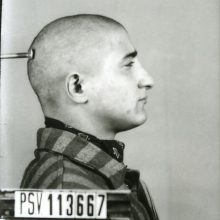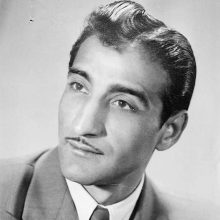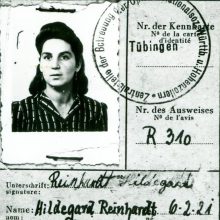Difficult new beginnings
The first few years after the liberation were marked by the desperate and often long drawn-out search for those family members who had survived. The vast majority of Sinti and Roma had lost all their possessions during the Nazi persecution and had to go about rebuilding their lives. And they were not able to rely on support from official authorities. On the contrary: the cities and municipalities treated the concentration camp survivors as foreigners in their own country and engaged in a policy of exclusion.
Many Sinti and Roma in the newly founded Federal Republic of Germany continued to be denied the German citizenship previously revoked under the Nazis. And since the survivors had been forced to give up their personal papers under the persecution, they and their descendants were declared ‘stateless’, even though their families had been firmly rooted in Germany for generations.
01.1 | The Munich Sinto Josef Höllenreiner and his wife Sofie in 1941. They were deported to Auschwitz-Birkenau in March 1943 along with their six children. Documentation Centre Archives
01.1
01.2 | Josef Höllenreiner in 1946 after he returned from the concentration camps Documentation Centre Archives
01.2
02 | Among the few supporters of the surviving Sinti and Roma was the well-known painter Otto Pankok, whose art had been declared ‘degenerate’ by the Nazi regime. Since the early 1930s Pankok had been in close contact with Düsseldorf’s Sinti community and painted numerous portraits of them. After the war he was appointed professor […]
02
03.1 | Special ID belonging to Romanus Kreutz as ‘rassisch Verfolgter’, i.e. a person persecuted on racial grounds, issued by the Düsseldorf district special assistance committee on 3 April 1948. Romanus Kreutz was born in the Düsseldorf-Höherweg camp in 1939 and deported with his family to occupied Poland in May 1940. Four of his siblings […]
03.1
03.2 | Special ID belonging to Romanus Kreutz as ‘rassisch Verfolgter’, i.e. a person persecuted on racial grounds, issued by the Düsseldorf district special assistance committee on 3 April 1948. Romanus Kreutz was born in the Düsseldorf-Höherweg camp in 1939 and deported with his family to occupied Poland in May 1940. Four of his siblings […]
03.2
04.1 | Reinhard Florian as an Auschwitz prisoner. The Sinto, originally from East Prussia, was imprisoned in concentration camps at Auschwitz-Monowitz and Mauthausen, among others. His mother and seven siblings all fell victim to the genocide. Due to the changes in the geopolitical situation, he was unable to return to his East Prussian homeland after […]
04.1
04.2 | Reinhard Florian in a photograph taken during the first few years after the war. Documentation Centre Archives
04.2
04.3 | Reinhard Florian
04.3
04.4 | Handwritten list with names of prisoners liberated from the Ebensee camp (a subcamp of Mauthausen concentration camp) from 9 May 1945. Reinhard Florian is No. 93. National Archives and Records Administration, Washington D.C.
04.4
05.1 | In the early days following the liberation, Allied and German authorities issued Sinti and Roma survivors with statements or IDs attesting to the concentration camp imprisonment to which they had been subjected. Documentation Centre Archives
05.1
05.2 | In the early days following the liberation, Allied and German authorities issued Sinti and Roma survivors with statements or IDs attesting to the concentration camp imprisonment to which they had been subjected. Documentation Centre Archives
05.2
05.3 | In the early days following the liberation, Allied and German authorities issued Sinti and Roma survivors with statements or IDs attesting to the concentration camp imprisonment to which they had been subjected. Documentation Centre Archives
05.3















